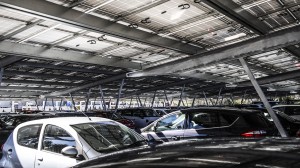 Eastbourne District General Hospital Veolia has begun energy generation from a solar array installed in its car park, which will provide power for EV charging points and the hospital.
Eastbourne District General Hospital Veolia has begun energy generation from a solar array installed in its car park, which will provide power for EV charging points and the hospital.
The solar car park was installed by Veolia and solar car park specialists 3ti and it is expected to generate 1,000MWh per year.
The new solar array comprises over 2,412 solar panels across eight canopies that cover 400 car parking spaces. The hospital will make significant savings by generating its own renewable electricity on site and the array also addresses the need for workplace electric vehicle (EV) charging by providing ten solar-powered EV charge points for staff use.
By covering the car parking areas the solar canopies also provide shelter from the elements, and give enhanced security in the form of overhead lighting.
The car park is part of a £27 million energy management contract with Veolia to upgrade Eastbourne District General Hospital, deliver energy upgrades and target carbon savings of 4,129 tonnes per year. Funding was provided through the Public Sector Decarbonisation Scheme and Veolia says it takes a whole building approach that accounts for how facilities and the energy delivery systems interact with each other.
Chris Hodgson, Director of Estates and Facilities at East Sussex Healthcare NHS Trust, said:
“The completion of the new solar array is another significant step on our journey to net zero. The solar farm alongside other improvements, including new insulation and heat pumps, at Eastbourne district general hospital will lead to a significant reduction in the use of energy across the site which will be a key part of our work to provide sustainable healthcare.”
Tim Evans, founder and chief executive at 3ti, added: “This project is a win-win for all parties: the SCP provides low-cost and low-carbon electricity for the hospital, car park users benefit from the cover and lighting provided by the canopies, and staff with EVs can charge their cars whilst at work. EDGH has proven how simple it can be for organisations to transform car parks into a renewable energy source and leave something better behind for future generations.”